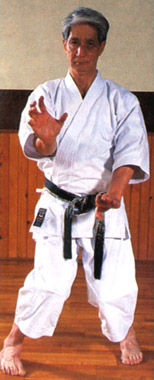Hidetaka Nishiyama
Hidetaka Nishiyama ( jap. 西山英隆 , Nishiyama Hidetaka * 10 October 1928 in the district Kōtō in Tokyo , Japan ; † 7. November 2008 in Los Angeles , USA ) an international, was Japanese Shotokan - Karate champion and winner of the 10th Dan . He learned under the style founder Gichin Funakoshi and was involved in setting up the Japan Karate Association (JKA).
youth
Nishiyama was born in Tokyo on October 10, 1928, the son of a lawyer. He had two sisters. In 1933 he began, according to tradition, at the age of five on May 5th (the Kodomo no hi ) with the Kendō training, in 1939 the Jūdō was added. At the age of 14 he reached the 1st Dan in Jūdō and a year later in 1943 the 1st Dan in Kendō, in which he progressed to the 3rd Dan. In 1943 he also began karate training under Gichin Funakoshi and his son Gigō Funakoshi .
Nishiyama served in the Japanese Navy before the end of World War II , which is why he had to interrupt his training. In 1945 he began to study at Takushoku University and became a member of the local karate club. In 1946 he reached the 1st dan in karate and the 2nd dan followed in 1948. In 1949 he was appointed team captain of the karate club.
Time in the Japan Karate Association
In 1951, Nishiyama graduated from Takushoku University with a Master of Arts degree in economics . In the same year he became a member of the board of the Japan Karate Association (JKA). He started out at Shell Oil, but his role at JKA soon turned into a full-time job. He was assigned the supervision of the JKA instructor program, which has produced some well-known karate masters.
In 1952 he began to train US military members of the Strategic Air Command (SAC) together with Masatoshi Nakayama and Isao Obata . The following year, Nishiyama and others were invited to the United States to teach at various military bases for a period of three months.
Published in 1960 his book Nishiyama Karate: The Art of Empty-Hand Fighting (dt. Karate: the art of the empty hand ), which is now one of the best selling karate books.
Living in the USA
In 1961 Nishiyama went to Los Angeles at the invitation of his students from the SAC and some JKA members, where he built his dojo. He founded the All American Karate Federation (AAKF) for amateur karate and organized the first national karate championships under its umbrella.
In 1974 he founded the International Amateur Karate Federation (IAKF) from which the International Traditional Karate Federation (ITKF) should emerge in 1986 . In 1979 the AAKF became the American Amateur Karate Federation (with the same acronym AAKF), of which Nishiyama became the founding president. In the following years he had other leadership roles, including a. as President of JKA International (USA).
To make karate Olympic, Nishiyama sent a request to the International Olympic Committee in 1976 . At the beginning of the 1990s, the ITKF and the World Union of Karate Do Organizations (WUKO) were supposed to join forces for this purpose, but this was not realized and represented a setback for karate at the Olympics. The WUKO and the ITKF then formed a confederation, which two years later was recognized by the IOC as the only world association for karate sport. Since 1992 this association has been called the World Karate Federation (WKF).
honors and awards
In 1999 Nishiyama was honored with the US flag , which was hoisted over the Capitol in Washington, DC on October 10th (his birthday) to honor his contribution to the spread of traditional karate.
On November 3, 2000, Nishiyama was awarded the Order of the Sacred Treasure 4th class by the Tennō in a ceremony on the grounds of the Imperial Palace in Tokyo .
In Poland in 2001 he was awarded the Polish Order of Merit 4th Class (Officer's Cross) by the Polish President Aleksander Kwaśniewski .
Publications
- Hidetaka Nishiyama, Richard C. Brown: Karate: The Art of Empty-Hand Fighting , Charles E. Tuttle, Tokyo, 1960.
- Hidetaka Nishiyama, Richard C. Brown: Karate: The Art of the Empty Hand , 2001, ISBN 978-3-937745-06-0
Individual evidence
Web links
- Official website (English)
- International Traditional Karate Federation
- Short biography (English; PDF; 230 kB)
| personal data | |
|---|---|
| SURNAME | Nishiyama, hidetaka |
| ALTERNATIVE NAMES | 西山 英 隆 (Japanese) |
| BRIEF DESCRIPTION | japanese karate teacher |
| DATE OF BIRTH | October 10, 1928 |
| PLACE OF BIRTH | Tokyo , Japan |
| DATE OF DEATH | November 7, 2008 |
| Place of death | Los Angeles , California , USA |
